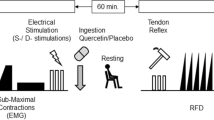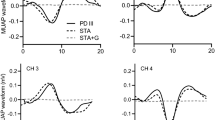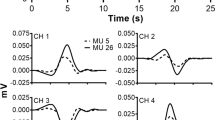Abstract
The aim of the present study was to investigate the acute effect of caffeine or quercetin ingestion on motor unit firing patterns and muscle contractile properties before and after resistance exercise. High-density surface electromyography (HDs-EMG) during submaximal contractions and electrically elicited torque in knee extensor muscles were measured before (PRE) and 60 min after (POST1) ingestion of caffeine, quercetin glycosides, or placebo, and after resistance exercise (POST2) in ten young males. The Convolution Kernel Compensation technique was used to identify individual motor units of the vastus lateralis muscle for the recorded HDs-EMG. Ingestion of caffeine or quercetin induced significantly greater decreases in recruitment thresholds (RTs) from PRE to POST1 compared with placebo (placebo: 94.8 ± 9.7%, caffeine: 84.5 ± 16.2%, quercetin: 91.9 ± 36.7%), and there were significant negative correlations between the change in RTs (POST1-PRE) and RT at PRE for caffeine (rs = − 0.448, p < 0.001) and quercetin (rs = − 0.415, p = 0.003), but not placebo (rs = − 0.109, p = 0.440). Significant positive correlations between the change in firing rates (POST2-POST1) and RT at PRE were noted with placebo (rs = 0.380, p = 0.005) and quercetin (rs = 0.382, p = 0.007), but not caffeine (rs = 0.069, p = 0.606). No significant differences were observed in electrically elicited torque among the three conditions. These results suggest that caffeine or quercetin ingestion alters motor unit firing patterns after resistance exercise in different threshold-dependent manners in males.







Similar content being viewed by others
Data availability
Data that support the findings of the present study are presented in the text, figures and table, and are available from the corresponding author upon reasonable request.
Abbreviations
- HDs-EMG:
-
High-density surface electromyography
- MVC:
-
Maximum voluntary contraction
- RT:
-
Recruitment threshold
- VL:
-
Vastus lateral
References
Adam A (2005) Firing rates of motor units in human vastus lateralis muscle during fatiguing isometric contractions. J Appl Physiol 99(1):268–280. https://doi.org/10.1152/japplphysiol.01344.2004
Alexander SP (2006) Flavonoids as antagonists at A1 adenosine receptors. Phytother Res 20(11):1009–1012. https://doi.org/10.1002/ptr.1975
Bazzucchi I, Felici F, Montini M, Figura F, Sacchetti M (2011) Caffeine improves neuromuscular function during maximal dynamic exercise. Muscle Nerve 43(6):839–844. https://doi.org/10.1002/mus.21995
Bazzucchi I, Patrizio F, Ceci R, Duranti G, Sgro P, Sabatini S, Di Luigi L, Sacchetti M, Felici F (2019) The effects of quercetin supplementation on eccentric exercise-induced muscle damage. Nutrients. https://doi.org/10.3390/nu11010205
Burak C, Brull V, Langguth P, Zimmermann BF, Stoffel-Wagner B, Sausen U, Stehle P, Wolffram S, Egert S (2017) Higher plasma quercetin levels following oral administration of an onion skin extract compared with pure quercetin dihydrate in humans. Eur J Nutr 56(1):343–353. https://doi.org/10.1007/s00394-015-1084-x
Burke RE, Levine DN, Tsairis P, Zajac FE 3rd (1973) Physiological types and histochemical profiles in motor units of the cat gastrocnemius. J Physiol 234(3):723–748. https://doi.org/10.1113/jphysiol.1973.sp010369
Cheuvront SN, Ely BR, Kenefick RW, Michniak-Kohn BB, Rood JC, Sawka MN (2009) No effect of nutritional adenosine receptor antagonists on exercise performance in the heat. Am J Physiol Regul Integr Comp Physiol 296(2):R394-401. https://doi.org/10.1152/ajpregu.90812.2008
Coombes JS, Powers SK, Rowell B, Hamilton KL, Dodd SL, Shanely RA, Sen CK (2001) Effects of vitamin E and alpha-lipoic acid on skeletal muscle contractile properties. J Appl Physiol 90(4):1424–1430. https://doi.org/10.1152/jappl.2001.90.4.1424
Coombes JS, Rowell B, Dodd SL, Demirel HA, Naito H, Shanely RA, Powers SK (2002) Effects of vitamin E deficiency on fatigue and muscle contractile properties. Eur J Appl Physiol 87(3):272–277. https://doi.org/10.1007/s00421-002-0631-3
Davis JM, Murphy EA, Carmichael MD (2009) Effects of the dietary flavonoid quercetin upon performance and health. Curr Sports Med Rep 8(4):206–213. https://doi.org/10.1249/JSR.0b013e3181ae8959
Del Vecchio A, Casolo A, Negro F, Scorcelletti M, Bazzucchi I, Enoka R, Felici F, Farina D (2019a) The increase in muscle force after 4 weeks of strength training is mediated by adaptations in motor unit recruitment and rate coding. J Physiol 597(7):1873–1887. https://doi.org/10.1113/JP277250
Del Vecchio A, Negro F, Holobar A, Casolo A, Folland JP, Felici F, Farina D (2019b) You are as fast as your motor neurons: speed of recruitment and maximal discharge of motor neurons determine the maximal rate of force development in humans. J Physiol 597(9):2445–2456. https://doi.org/10.1113/JP277396
Desbrow B, Biddulph C, Devlin B, Grant GD, Anoopkumar-Dukie S, Leveritt MD (2012) The effects of different doses of caffeine on endurance cycling time trial performance. J Sports Sci 30(2):115–120. https://doi.org/10.1080/02640414.2011.632431
Farina D, Holobar A, Merletti R, Enoka RM (2010) Decoding the neural drive to muscles from the surface electromyogram. Clin Neurophysiol 121(10):1616–1623. https://doi.org/10.1016/j.clinph.2009.10.040
Francic A, Holobar A (2021) On the reuse of motor unit filters in high density surface electromyograms recorded at different contraction levels. Ieee Access 9:115227–115236. https://doi.org/10.1109/Access.2021.3104762
Fuglevand AJ, Winter DA, Patla AE (1993) Models of recruitment and rate coding organization in motor-unit pools. J Neurophysiol 70(6):2470–2488. https://doi.org/10.1152/jn.1993.70.6.2470
Gallego JA, Dideriksen JL, Holobar A, Ibanez J, Glaser V, Romero JP, Benito-Leon J, Pons JL, Rocon E, Farina D (2015a) The phase difference between neural drives to antagonist muscles in essential tremor is associated with the relative strength of supraspinal and afferent input. J Neurosci 35(23):8925–8937. https://doi.org/10.1523/JNEUROSCI.0106-15.2015
Gallego JA, Dideriksen JL, Holobar A, Ibanez J, Pons JL, Louis ED, Rocon E, Farina D (2015b) Influence of common synaptic input to motor neurons on the neural drive to muscle in essential tremor. J Neurophysiol 113(1):182–191. https://doi.org/10.1152/jn.00531.2014
Graham TE (2001) Caffeine and exercise: metabolism, endurance and performance. Sports Med 31(11):785–807. https://doi.org/10.2165/00007256-200131110-00002
Grgic J (2021) Effects of caffeine on resistance exercise: a review of recent research. Sports Med 51(11):2281–2298. https://doi.org/10.1007/s40279-021-01521-x
Grgic J, Mikulic P, Schoenfeld BJ, Bishop DJ, Pedisic Z (2019) The influence of caffeine supplementation on resistance exercise: a review. Sports Med 49(1):17–30. https://doi.org/10.1007/s40279-018-0997-y
Grgic J, Grgic I, Pickering C, Schoenfeld BJ, Bishop DJ, Pedisic Z (2020) Wake up and smell the coffee: caffeine supplementation and exercise performance-an umbrella review of 21 published meta-analyses. Br J Sports Med 54(11):681–688. https://doi.org/10.1136/bjsports-2018-100278
Haider G, Folland JP (2014) Nitrate supplementation enhances the contractile properties of human skeletal muscle. Med Sci Sports Exerc 46(12):2234–2243. https://doi.org/10.1249/MSS.0000000000000351
Henneman E, Olson CB (1965) Relations between Structure and Function in the Design of Skeletal Muscles. J Neurophysiol 28:581–598. https://doi.org/10.1152/jn.1965.28.3.581
Henneman E, Somjen G, Carpenter DO (1965) Functional Significance of Cell Size in Spinal Motoneurons. J Neurophysiol 28:560–580. https://doi.org/10.1152/jn.1965.28.3.560
Holobar A, Zazula D (2004) Correlation-based decomposition of surface electromyograms at low contraction forces. Med Biol Eng Comput 42(4):487–495. https://doi.org/10.1007/BF02350989
Holobar A, Zazula D (2008) On the selection of the cost function for gradient-based decomposition of surface electromyograms. Annu Int Conf IEEE Eng Med Biol Soc 2008:4668–4671. https://doi.org/10.1109/IEMBS.2008.4650254
Holobar A, Farina D, Gazzoni M, Merletti R, Zazula D (2009) Estimating motor unit discharge patterns from high-density surface electromyogram. Clin Neurophysiol 120(3):551–562. https://doi.org/10.1016/j.clinph.2008.10.160
Holobar A, Minetto MA, Farina D (2014) Accurate identification of motor unit discharge patterns from high-density surface EMG and validation with a novel signal-based performance metric. J Neural Eng 11(1):016008. https://doi.org/10.1088/1741-2560/11/1/016008
Kalmar JM (1985) Cafarelli E (1999) Effects of caffeine on neuromuscular function. J Appl Physiol 87(2):801–808. https://doi.org/10.1152/jappl.1999.87.2.801
Kamimori GH, Karyekar CS, Otterstetter R, Cox DS, Balkin TJ, Belenky GL, Eddington ND (2002) The rate of absorption and relative bioavailability of caffeine administered in chewing gum versus capsules to normal healthy volunteers. Int J Pharm 234(1–2):159–167. https://doi.org/10.1016/s0378-5173(01)00958-9
Kunugi S, Holobar A, Kodera T, Toyoda H, Watanabe K (2021) Motor unit firing patterns on increasing force during force and position tasks. J Neurophysiol 126(5):1653–1659. https://doi.org/10.1152/jn.00299.2021
Lee EH, Meissner G, Kim DH (2002) Effects of quercetin on single Ca(2+) release channel behavior of skeletal muscle. Biophys J 82(3):1266–1277. https://doi.org/10.1016/S0006-3495(02)75483-0
Lopes JM, Aubier M, Jardim J, Aranda JV, Macklem PT (1983) Effect of caffeine on skeletal muscle function before and after fatigue. J Appl Physiol Respir Environ Exerc Physiol 54(5):1303–1305. https://doi.org/10.1152/jappl.1983.54.5.1303
Lulic-Kuryllo T, Inglis JG (2022) Sex differences in motor unit behaviour: A review. J Electromyogr Kinesiol 66:102689. https://doi.org/10.1016/j.jelekin.2022.102689
Lynge J, Hellsten Y (2000) Distribution of adenosine A1, A2A and A2B receptors in human skeletal muscle. Acta Physiol Scand 169(4):283–290. https://doi.org/10.1046/j.1365-201x.2000.00742.x
Makino T, Shimizu R, Kanemaru M, Suzuki Y, Moriwaki M, Mizukami H (2009) Enzymatically modified isoquercitrin, alpha-oligoglucosyl quercetin 3-O-glucoside, is absorbed more easily than other quercetin glycosides or aglycone after oral administration in rats. Biol Pharm Bull 32(12):2034–2040. https://doi.org/10.1248/bpb.32.2034
McLellan TM, Caldwell JA, Lieberman HR (2016) A review of caffeine’s effects on cognitive, physical and occupational performance. Neurosci Biobehav Rev 71:294–312. https://doi.org/10.1016/j.neubiorev.2016.09.001
Merletti R, Holobar A, Farina D (2008) Analysis of motor units with high-density surface electromyography. J Electromyogr Kinesiol 18(6):879–890. https://doi.org/10.1016/j.jelekin.2008.09.002
Murota K, Matsuda N, Kashino Y, Fujikura Y, Nakamura T, Kato Y, Shimizu R, Okuyama S, Tanaka H, Koda T, Sekido K, Terao J (2010) alpha-Oligoglucosylation of a sugar moiety enhances the bioavailability of quercetin glucosides in humans. Arch Biochem Biophys 501(1):91–97. https://doi.org/10.1016/j.abb.2010.06.036
Neyroud D, Cheng AJ, Donnelly C, Bourdillon N, Gassner AL, Geiser L, Rudaz S, Kayser B, Westerblad H, Place N (2019) Toxic doses of caffeine are needed to increase skeletal muscle contractility. Am J Physiol Cell Physiol 316(2):C246–C251. https://doi.org/10.1152/ajpcell.00269.2018
Patrizio F, Ditroilo M, Felici F, Duranti G, De Vito G, Sabatini S, Sacchetti M, Bazzucchi I (2018) The acute effect of Quercetin on muscle performance following a single resistance training session. Eur J Appl Physiol 118(5):1021–1031. https://doi.org/10.1007/s00421-018-3834-y
Pickering C, Grgic J (2019) Caffeine and Exercise: What Next? Sports Med 49(7):1007–1030. https://doi.org/10.1007/s40279-019-01101-0
Pollock RD, Woledge RC, Martin FC (2012) Effects of whole body vibration on motor unit recruitment and threshold. J Appl Physiol 112(3):388–395. https://doi.org/10.1152/japplphysiol.01223.2010
Romaiguere P, Vedel JP, Azulay JP, Pagni S (1991) Differential activation of motor units in the wrist extensor muscles during the tonic vibration reflex in man. J Physiol 444:645–667. https://doi.org/10.1113/jphysiol.1991.sp018899
Skinner TL, Desbrow B, Arapova J, Schaumberg MA, Osborne J, Grant GD, Anoopkumar-Dukie S, Leveritt MD (2019) Women experience the same ergogenic response to caffeine as men. Med Sci Sports Exerc 51(6):1195–1202. https://doi.org/10.1249/MSS.0000000000001885
Spriet LL (2014) Exercise and sport performance with low doses of caffeine. Sports Med 44(2):S175-184. https://doi.org/10.1007/s40279-014-0257-8
ter Haar Romeny BM, Denier van der Gon JJ, Gielen CC (1982) Changes in recruitment order of motor units in the human biceps muscle. Exp Neurol 78(2):360–368. https://doi.org/10.1016/0014-4886(82)90054-1
Tomita A, Kawade S, Moritani T, Watanabe K (2020) Novel perspective on contractile properties and intensity-dependent verification of force-frequency relationship during neuromuscular electrical stimulation. Physiol Rep 8(22):e14598. https://doi.org/10.14814/phy2.14598
Watanabe K, Holobar A (2021) Quercetin ingestion modifies human motor unit firing patterns and muscle contractile properties. Exp Brain Res 239(5):1567–1579. https://doi.org/10.1007/s00221-021-06085-w
Watanabe K, Holobar A, Kouzaki M, Ogawa M, Akima H, Moritani T (2016) Age-related changes in motor unit firing pattern of vastus lateralis muscle during low-moderate contraction. Age (dordr) 38(3):48. https://doi.org/10.1007/s11357-016-9915-0
Watanabe K, Holobar A, Mita Y, Kouzaki M, Ogawa M, Akima H, Moritani T (2018) Effect of resistance training and fish protein intake on motor unit firing pattern and motor function of elderly. Front Physiol 9:1733. https://doi.org/10.3389/fphys.2018.01733
Watanabe K, Holobar A, Mita Y, Tomita A, Yoshiko A, Kouzaki M, Uchida K, Moritani T (2020) Modulation of neural and muscular adaptation processes during resistance training by fish protein ingestions in older adults. J Gerontol A Biol Sci Med Sci 75(5):867–874. https://doi.org/10.1093/gerona/glz215
Yavuz US, Negro F, Sebik O, Holobar A, Frommel C, Turker KS, Farina D (2015) Estimating reflex responses in large populations of motor units by decomposition of the high-density surface electromyogram. J Physiol 593(19):4305–4318. https://doi.org/10.1113/JP270635
Acknowledgements
This study was supported by the Bilateral Program of JSPS (JPJSBP-82626) to KW and AH and by the Slovenian Research Agency (project J2-1731, L7-9421 and Program funding P2-0041) to AH.
Author information
Authors and Affiliations
Contributions
TN contributed to analysis and interpretation of data; and drafting the article and revising it critically for important intellectual content. TN, TH, AH, SK, MO and TO contributed to conception and design of the experiments; collection, analysis, and interpretation of data; and revising the article for important intellectual content. K.W. obtained funding support; contributed to collection, analysis and interpretation of data; and also contributed to drafting the article and revising it critically for important intellectual content. All authors approved the final version of the manuscript. The authors have no disclosures.
Corresponding author
Ethics declarations
Conflict of interest
There are no competing interests.
Additional information
Communicated by Westerterp/Westerblad.
Publisher's Note
Springer Nature remains neutral with regard to jurisdictional claims in published maps and institutional affiliations.
Rights and permissions
Springer Nature or its licensor (e.g. a society or other partner) holds exclusive rights to this article under a publishing agreement with the author(s) or other rightsholder(s); author self-archiving of the accepted manuscript version of this article is solely governed by the terms of such publishing agreement and applicable law.
About this article
Cite this article
Nishikawa, T., Hirono, T., Holobar, A. et al. Acute effects of caffeine or quercetin ingestion on motor unit firing pattern before and after resistance exercise. Eur J Appl Physiol (2024). https://doi.org/10.1007/s00421-023-05376-0
Received:
Accepted:
Published:
DOI: https://doi.org/10.1007/s00421-023-05376-0




